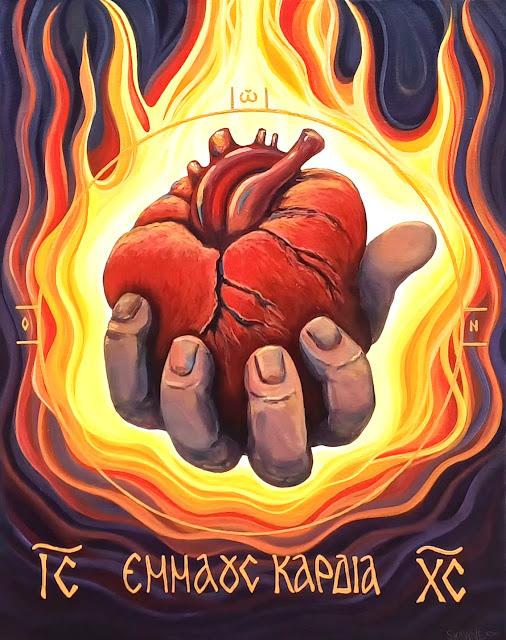Emmaus Heart
16 in. x 20 in., acrylic on canvas
Prints of this piece are available at my online print shop:
https://www.inprnt.com/gallery/shawne/
(Original not yet priced; unframed)
You might be familiar with the oft-seen "sacred heart of Jesus" image, on fire, wounded, topped with a cross and surrounded by thorns, popularized chiefly in the painting by artist Pompeo Batoni (1708 -1787). Batoni's painting is based on a supposed apparition of Jesus to Catholic nun Margaret Mary Alacoque in France in 1673.
This is not that. Quite the opposite.
While the flaming "sacred heart" imagery is supposed to be a depiction of the love that Jesus has for mankind, frankly, I'm a Biblicist. And the only reference explicitly describing a burning heart in the scriptures is in Luke 24:32. And the heart doesn't belong to Jesus. It belongs to His disciples.
His disciples, who have just experienced the presence of the living, resurrected Jesus, Himself.
This painting uses iconography elements and is based on a stunning incident from Luke 24:13-35.
On Easter evening, Jesus, after his resurrection, catches up with two disciples walking the seven miles from Jerusalem to Emmaus where they live. They don't recognize Him, and He doesn't immediately reveal Himself. He asks what they are talking about, and they tell Him about "all the things that have happened as of late" in Jerusalem over the Passover weekend. He plays dumb and asks, "What things?" They are incredulous and remark that He has to be the only person who hasn't heard all the news. They express their great grief over the murder of their Rabbi by crucifixion, their dashed hopes that He was the promised Messiah, and their perplexity that they've heard rumors of His resurrection... and they don't know what to think. Jesus chides them that they don't know the scriptures well enough, because if they did, they'd understand that the Messiah was foretold to suffer in like manner. For the rest of the walk to Emmaus, He explains the scriptures to them to put together the puzzle pieces they aren't seeing. Upon arriving at their house, they invite Him in, and as He breaks the bread for supper with them, suddenly, they recognize Him!
And then He just... vanishes.
This piece is an illumination of their wild exclamation to each other, right before they put their sandals back on and ran back to Jerusalem to tell the others:
"Did not our hearts burn within us while He talked to us on the road, while He opened to us the scriptures?"
The hand in the icon is Christ's. Is the heart yours?
For those who may be unfamiliar with Greek icons, allow me to decode what you're looking at. The IX XC inscription is a Christogram: the iconographical shorthand for Jesus Christ. The Greek inscription Εμμαύς Καρδιά is Emmaus Heart. The circular nimbus around the hand holding the heart with the cruciform elements around the outside edge denotes Christ and the Greek letters contained there Ὁ Ὤ Ν means "He who is."
